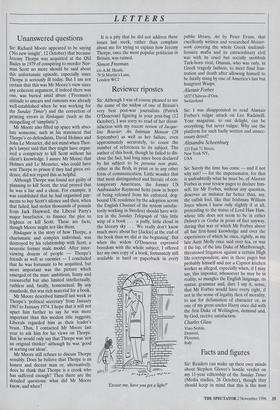Facts and figures
Sir: Readers can make up their own minds about Stephen Glover's hostile verdict on my 11-year editorship of the Sunday Times (Media studies, 26 October), though they should keep in mind that this is the man who launched the Independent on Sunday with the specific intention of toppling the Sunday Times as market leader and who failed so magnificently to come anywhere near us. I think his failure has somewhat warped his judgment. It certainly makes me less inclined to believe I have much to learn from him about Sunday papers.
But these are subjective matters. What Mr Glover cannot be allowed to get away with is the deliberate distortion of the facts to suit his hatchet-job purposes. He writes that when I became editor, in the autumn of 1983, sales of the Sunday Times were 1,338,000 and that when I stepped down they were only around 1,200,000.
Mr Glover has chosen two months to put the worst possible gloss on my record. But even the most junior media correspondent knows that single-month sales figures tell you nothing. What matters is the rolling six- month averages. These are the facts: in the first half of 1983 (the six months before I became editor) sales were 1.285 million; in the second half of 1993 (my last full six months) sales were 1.231 million.
This fall of 50,000 is a good deal less than the one suggested by Mr Glover. It is a record on which I am happy to be judged, especially when it is put in context. The fig- ures for the first half of 1983 were inflated by the extra sales generated by the Hitler Diaries fiasco. In 1983 there were three national Sunday broadsheets; by 1993 there were four. There had also been a huge expansion of Saturday papers, many only partly read by Sunday morning, which inhibited Sunday sales. And the Mail on Sunday was continuing its well-financed marketing, eating into the bottom end of the Sunday broadsheet market in the process.
Despite these new competitive elements, there were many months when the Sunday Times sold well over 1.3 million. Overall it managed to increase its market share and widen the lead over its competitors: by 1993 the Sunday Times was more dominant than ever in the Sunday quality market, regularly selling 150,000 more than the Observer and Sunday Telegraph combined — and the Independent on Sunday was a receding speck on the horizon.
The last independent readership survey done during my editorship also showed a huge increase in what advertisers call ABC1s (the most affluent and best educat- ed in society) reading the paper and a fall among poorer and less well educated peo- ple — which rather belies Mr Glover's claim that I took the paper downmarket.
Andrew Neil
London SW7
Stephen Glover replies: I don't know why in his characteristically charming letter Andrew Neil gets so worked up about the figure of 1,338,000. He mentions it himself on page 52 of his new book as the circulation which he inher- ited at the Sunday Times. One can, by pre- senting figures in another way, put on a gloss slightly more favourable to Mr Neil. If you compare the average sales in the six months preceding his editorship with his last six months in the editorial chair, you come up with a fall of 65,000, or 5 per cent of circulation.
The point is that, however one cuts the figures, the sales of the Sunday Times declined while Mr Neil was editor. The fall is not huge, but it cannot be denied. It is worth mentioning only because Mr Neil talks and writes as though he single-hand- edly turned around the paper. Even some of his critics have come to believe that, whatever else he may have done, he did at least put up its sales. He did not. Nor did he — contrary to what I wrote, last week and to what Mr Neil now asserts — increase the Sunday Times's market share. Figures from the Audit Bureau of Circula- tions show that this fell very slightly over the period of Mr Neil's editorship.
As for his claim that the paper did not go downmarket, I know of no one else who believes this. Mr Neil himself appears not to in his book. On page 420 he writes that `the beauty of a multi-sectioned newspaper is that you can go up- and down-market at the same time. He adds that his new 'Style' section 'protected our middle-market flank'. Need he say more?



















































































 Previous page
Previous page